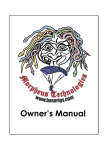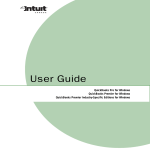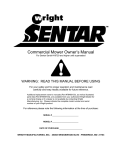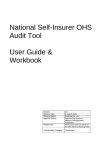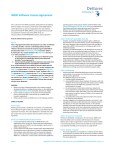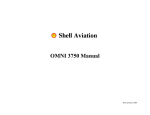Download Wiley Microsoft SharePoint 2007 For Dummies
Transcript
Chapter 1 AL Getting to Know SharePoint Figuring out licensing requirements Discovering SharePoint’s role in your organization Deciding which projects to start with D I MA Getting ready to implement SharePoint TE Identifying the technologies that enable SharePoint RI In This Chapter GH TE f you believe everything you read on the Internet (and who doesn’t?), you know that SharePoint is either an over-hyped Microsoft product with no real business value or it’s the next Messiah in information and knowledge management. So, which is it? Only you can answer that question. CO PY RI SharePoint’s usefulness in your organization is determined by whether SharePoint has a role in your existing information systems environment. To determine SharePoint’s role, you really have to understand what SharePoint is and what it does. However, simply having this knowledge doesn’t guarantee you a successful SharePoint implementation. However, it does give you a strong foundation, which is what this chapter is all about. Understanding SharePoint Technology SharePoint is a family of technologies from Microsoft that provides a server infrastructure to support the needs of information workers and their employers. These needs include collaboration, knowing who’s online, document storage, and the ability to inform and be informed. The companies that hire information workers need to audit, monitor, organize, retain, and protect information. SharePoint makes it possible for companies to engage all their information workers through the tools people are using already — Office clients (such as Word and Excel), Internet browsers (such as Internet Explorer), and e-mail clients (such as Outlook). Obviously, SharePoint works best with Office 2007. Whether you’re using Office 2007 or OpenOffice, SharePoint gives employers a means to connect with workers where they work — at their desktops. 12 Part I: Setting Up SharePoint By reaching workers where they work, companies can use SharePoint as a key component for implementing new strategic initiatives and internal communications plans. Beyond sending blast e-mails and convening one-time town hall meetings, companies can use SharePoint to integrate information about campaigns, achievement of performance objectives, and company news into workers’ daily routines. Sound like information overload? It need not be. SharePoint makes it easy to target content so that people see only the information that’s relevant to achieving their objectives. With SharePoint, companies can create a managed information environment that isn’t centrally managed. Yes, it’s secure, protected, and audited, but workers make decisions about how information is organized. If workers change their minds about the organizing structure, it can be changed easily. By evaluating the ways that employees set up their work environments in SharePoint — where they store documents, the properties they affix to documents, and with whom they’re collaborating — the information environment created in SharePoint can provide companies with valuable feedback. When’s the last time your information environment told you how many Word documents pertained to a particular customer account or product? You can get that kind of information from SharePoint. SharePoint also provides workers with the ability to connect with each other. Instead of sending files back and forth via e-mail, workers can set up information environments that make it easy to collaborate on documents or share a calendar. SharePoint uses a Web site infrastructure to deliver the bulk of its features. Users can use a Web browser or familiar Office clients, such as Word and Excel, to access SharePoint’s features. Office clients enable information workers to use familiar tools in new ways, which reduces training and support costs and increases solution development opportunities. SharePoint offers organizations a much faster return on investment because SharePoint fits neatly into most companies’ existing technology infrastructures. SharePoint isn’t a new technology. The ability to provision team sites for use with Office clients was first introduced in May 2001 (as shown in Figure 1-1) with a product called SharePoint Team Services. SharePoint Portal Server 2001, a product for connecting team sites, was released in June 2001. With each subsequent release, more and more features were added. Windows SharePoint Services (WSS) version 3, which was released in November 2006, represents a major re-architecting of the product. Starting with the 2003 release, WSS became a component of the Windows Server operating system. The portal product, SharePoint Portal Server 2003, released alongside Office 2003. The latest release, Microsoft Office SharePoint Server (MOSS) 2007, is now officially part of the Microsoft Office suite of products. Chapter 1: Getting to Know SharePoint SharePoint Release Timeline SharePoint Team Services v1.0 releases with Office XP WSS v2.0 releases June 2001 May 2001 WSS v3.0 releases November 2003 June 2003 SharePoint Portal Server 2001 releases January 2007 November 2006 SharePoint Portal Server 2003 releases with Office 2003 Microsoft Office SharePoint Server 2007 releases with Office 2007 SharePoint Support Schedule STS v1.0 Mainstream Extended Support Ends Support Ends May 2001 July 2006 SPS 2001 July 2006 July 2011 WSS v2 July 2008 July 2013 SPS 2003 Nov 2009 January 2014 MOSS 2007 April 2012 April 2017 Version Figure 1-1: SharePoint product release timeline. In the days of client/server applications, an application commonly consisted of a relatively short stack of technologies. A Windows application might be written in a programming language, such as Visual Basic, that accesses a database on a database server. As long as you had network connectivity and your database was up and running, probability was high that you could use the application. More importantly, installing, supporting, maintaining, and troubleshooting the application was relatively easy. In the same way that today’s information workers don’t work in isolation, neither can SharePoint. To support the needs of workers and their employers, SharePoint requires a relatively high stack of technologies. Understanding SharePoint’s technologies in broad terms is important because this knowledge helps you do the following: Identify opportunities for reuse and customization: When you gain an understanding of the technologies SharePoint uses, you can leverage some of your existing infrastructure. You don’t have to start at square one. Also, you can extend SharePoint to find new ways to use the infrastructure. Troubleshoot SharePoint: You’ll encounter many points of failure in SharePoint — and discover that many aren’t actually part of the SharePoint software proper. By understanding how SharePoint works and which technologies SharePoint uses, you can develop a systematic approach to troubleshooting. 13 14 Part I: Setting Up SharePoint Understand the skills necessary to implement and support SharePoint: SharePoint requires a lot of skills, and it’s not likely that you have all of them. I know I sure don’t. You have to make arrangements to acquire the skills you don’t have in-house. The SharePoint family of technologies consists of several products. In this book, I focus on the two primary SharePoint products: Windows SharePoint Services (WSS) and Microsoft Office SharePoint Server 2007 (MOSS). Each of these products has a different role in the stack of SharePoint technologies. See the section, “Licensing SharePoint,” later in this chapter, for a complete rundown of all the products available in the SharePoint family. Laying the foundation The core product in the family of SharePoint technologies is Windows SharePoint Services (WSS). Because WSS is the foundational product, no other product in the SharePoint family is possible without it. WSS is a full-blown ASP.NET 2.0 Web application, which means it runs hosted inside ASP.NET. When you install WSS, you have to install ASP.NET and everything it requires to run, including the following: Internet Information Services (IIS) version 6 or 7: This is Microsoft’s Web server, which is used to host SharePoint. Most typical SharePoint usage scenarios can configure IIS from within SharePoint. You don’t have to manage IIS directly very often. .NET Framework version 2.0 and 3.0: This is a set of software that installs ASP.NET and Windows Workflow Foundation (WF). After you enable ASP.NET 2.0 on the server, you don’t have to do anything else to configure .NET. SQL Server 2000 or later: This is Microsoft’s database management system. SharePoint can create all the databases it needs, or you can create them yourself. You’re responsible for managing backups of your data. Windows Server 2003 or later: This is Microsoft’s server operating system. Monitor the servers that host SharePoint just like you would any server. I walk you through installing these technologies on your server in Chapter 2. Figure 1-2 shows the stack of technologies required to run WSS. Note that these are logical servers. Your implementation may include several physical servers. Chapter 1: Getting to Know SharePoint Windows SharePoint Services Database Server SQL Server .NET Framework Windows Workflow Foundation ASP.NET Figure 1-2: SharePoint requires Web Server many enabling technologies. Operating System Internet Information Server Windows Server 2003 ASP.NET is the Microsoft platform for building Web applications. A Web application is more sophisticated than a Web site, which may only display information. Web applications can provide services, such as electronic commerce. Much of the ability to customize and extend SharePoint comes from ASP.NET 2.0. You can think of the technologies listed in Figure 1-2 as SharePoint’s enabling technologies. SharePoint requires these technologies in order to function properly. SharePoint integrates with many other technologies to provide extra functionality, such as Microsoft Exchange Server. See Chapter 9 for more information on such technologies. WSS provides the core set of services consumed by all products in the SharePoint family, especially MOSS 2007. These services include the following: Data storage and content management: WSS provides lists and libraries as structures for storing data. Lists are primarily used to store tabular data, whereas libraries store files. WSS provides a robust set of services for managing the data and files stored in lists and libraries, services that allow you to do the following: • Associate metadata with list items and files (see Chapter 7). • Create versions of list items and files (see Chapter 15). • Check out files for editing (see Chapter 15). • Index sites, lists, and libraries for searching purposes (see Chapter 14). 15 16 Part I: Setting Up SharePoint What’s in a name? When someone says SharePoint, what does he mean? Is he referring to a specific SharePoint product or the whole kit and caboodle? The only way to know for sure is to ask him. Although, don’t be surprised if you don’t get a straight answer. With SharePoint, you inevitably encounter an abundance of hype, misunderstanding, and uncertainty. Generally speaking, when someone says SharePoint, I find he usually means whichever SharePoint product is most relevant given the context of the discussion, or he’s just referring to the SharePoint technologies. Many people genuinely don’t know. Although I hate to add to the confusion, I find that constantly referring to a specific SharePoint product, such as WSS or MOSS 2007, is equally confusing. Because most people don’t know the difference between the two products, I usually just use the term SharePoint. In most cases, WSS can be used in many of the same ways as MOSS, so referring to them generically usually is technically correct. For example, both WSS and MOSS have document management features. (The MOSS features just expand on those found in WSS.) Similarly, MOSS has some very specific built-in features for business intelligence. However, that doesn’t mean that you couldn’t use WSS for business intelligence. In this book, I try to be specific about which product I’m referring to, especially when I’m talking about MOSS 2007. I often use the generic term SharePoint any time I’m referring to WSS or any feature that’s available in both products. • Manage content approval (see Chapter 15). • Use list items and libraries in a business process (See Chapter 8) WSS includes many specialized kinds of lists and libraries that you can use to perform certain tasks. See Chapter 4 for a complete run-down of the lists and libraries you encounter in SharePoint. Web platform and site model: All SharePoint’s features are delivered via a hierarchy of Web sites. It takes only a few mouse clicks to generate sites with SharePoint’s site provisioning model (see Chapter 4). SharePoint generates a full-featured Web site based on an XML configuration file. (WSS includes many of these configuration files that allow you to create a variety of SharePoint sites to suit the needs of your business. You can also customize the files or create your own.) Because SharePoint is an ASP.NET Web application, SharePoint is an excellent platform for delivering Web applications that include a Web part framework, navigation, and dynamic form and page generation. SharePoint gives you a viable alternative to building ASP.NET Web applications from scratch. Security: SharePoint provides a security-trimmed user interface so that users see only the options they have permissions for. SharePoint uses groups and roles for granting access to secure content, and virtually everything in SharePoint is securable. The most common authentication Chapter 1: Getting to Know SharePoint scenario for SharePoint is Active Directory, although SharePoint supports custom authentication schemes (such as forms-based authentication) as well. See Chapter 6 for more details on SharePoint’s security features. Management: SharePoint provides a multi-tiered administration model that makes it possible to isolate technical administrators from sensitive content. Administrators can’t see the files and other content that information workers save in SharePoint sites. Additional administration features include auditing, monitoring, and backing up and restoring tools. SharePoint provides specialized administration Web sites. All administrative features are also accessible from the command line and via code. Chapter 18 walks you through accessing the SharePoint administrative features. Services: A number of services are provided by SharePoint that support SharePoint’s other core services. These include notification services, such as RSS feeds, alerts, and inbound e-mail (see Chapter 10). WSS indexes all list, library, and site content so these items can be searched (see Chapter 14). SharePoint also provides migration tools to assist with deploying SharePoint. Application programming interfaces (APIs): SharePoint has a powerful object model and Web services. Everything you can do from the SharePoint user interface uses SharePoint APIs; thus, you can write code to access all SharePoint’s features. SharePoint makes available numerous before-and-after events that make it possible to customize SharePoint’s default behavior. Kicking it up a notch Given that WSS is an application platform, it makes sense that Microsoft has released several products that are built upon that application platform. MOSS 2007 is one such product; it’s essentially a WSS application. As a WSS application, MOSS consumes WSS resources and extends WSS to provide completely new features. Similar to how WSS consists of a set of services, MOSS adds the following services: Core services are the foundational features that enable MOSS 2007 applications. Core services of MOSS 2007 include personalization, search, business data catalog, and Excel Services. MOSS 2007’s core services are shared services because they’re shared across an entire SharePoint deployment. Application Services are the building blocks for creating applications in MOSS 2007. Examples include dashboards, workflows, and user profiles. These services are mixed and matched to provide a myriad of MOSS 2007 applications. 17 18 Part I: Setting Up SharePoint MOSS combines the services of WSS, along with its own core services and application services to create MOSS 2007 applications (see Figure 1-3). MOSS 2007 includes the following SharePoint applications right out of the box: Portals Enterprise People & Content Personalization Management Enterprise Search Business Process Integration Business Intelligence Microsoft Office SharePoint Server 2007 Figure 1-3: MOSS 2007 requires WSS. Data Storage & Content Management Web Platform & Site Model Security Management Services API Windows SharePoint Services Operating System Portals are an essential user interface feature of SharePoint and are used to aggregate content, highlight featured content, and provide access to other SharePoint resources (see Chapter 11). Enterprise content management consists of document and records management (see Chapter 15) as well as Web content management (see Chapter 16). WSS also provides document management, but MOSS adds to those features with information management policies and document information panels. I like to think of Web content management as MOSS’s publishing feature. Web content management makes it possible to publish content to a site that’s intended to be read by many people. People and personalization encompasses all the features related to managing user profiles, targeting content to audiences, and personalizing portal content. See Chapters 12 and 13. Enterprise search provides the ability to index all content within SharePoint and content outside SharePoint. Search is configurable so that you can manage the relevancy of results delivered to users. See Chapter 14. Business process integration provides the ability to integrate data from outside sources with SharePoint (see Chapter 17). MOSS can render InfoPath forms in the browser to automate business forms (see Chapter 8). Business intelligence provides support for reports, dashboards, and Excel Services (see Chapter 17). Excel Services creates server-side versions of Excel spreadsheets and renders them in a Web page. Chapter 1: Getting to Know SharePoint Chances are your company doesn’t rely on just one of these applications. In reality, you combine features from each application to meet your business’s needs. For example, your SharePoint implementation might be 75 percent document management and 25 percent business intelligence. Conversely, you might build your own SharePoint application by using the building blocks of WSS. If Microsoft’s Office developers can do it, so can you! Licensing SharePoint Figuring out which features go with which product is challenging. In this section, I explain the official products in the SharePoint family and what it takes to license them. Pricing varies depending on the kind of licensing agreement you have with Microsoft. All SharePoint deployments require Windows Server 2003. WSS version 3 is part of Windows Server 2003, so you don’t have to buy separate licenses for WSS. You can download WSS from the Microsoft Web site. MOSS 2007 products are available for purchase only through volume licensing agreements; you can’t buy them via retail channels. Microsoft offers several types of volume licensing agreements. The pricing associated with each agreement varies depending on the number of desktops in your organization, the benefits you receive, and whether you pay up-front or a certain amount each year. See the Microsoft Products Licensing Advisor at www.microsoft. com/licensing/mpla for assistance with choosing a licensing agreement. Properly licensing MOSS 2007 requires a combination of server licenses and Client Access Licenses (CALs). A server license allows you to run the software, such as MOSS 2007, on your server. Clients need a CAL to access the server’s features. Two types of CALs are used for MOSS 2007: Base CAL allows clients to access the portal, personalization, search, and enterprise content management features of MOSS 2007. Enterprise CAL allows clients to access the business intelligence and business process integration features of MOSS 2007 (such as the Report Center, Business Data Catalog, Excel Services, and InfoPath Forms Services). If you want users to access the features provided by the Enterprise CAL, you must also purchase a Base CAL. You need to provide an Enterprise CAL to only those clients who need to access the advanced services. You have the option to buy a separate CAL for each user or device. Talk with your software acquisition professional for advice on which approach best suits your organization. 19 20 Part I: Setting Up SharePoint Several additional SharePoint products go beyond MOSS 2007: MOSS 2007 for Search Standard Edition: This server license offers small- to medium-sized businesses all the features of Office SharePoint Server Search. The number of indexed documents is limited to 500,000. MOSS 2007 for Search Enterprise Edition: This server has no limit to the number of documents that can be indexed with this edition. MOSS 2007 for Internet Sites: This server license entitles you to use MOSS 2007 for Internet-facing Web sites that are accessed by nonemployees. No separate CALs are required. In addition to Windows Server 2003, you may need to implement the following: Microsoft SQL Server: All SharePoint content is stored in a back-end database. WSS installs with an internal database; however, you likely want to use SQL Server 2000 with service pack 4 or higher or SQL Server 2005 with service pack 1 or higher. Microsoft Internet Security and Acceleration (ISA) Server: To ensure that remote users are accessing SharePoint in the most secure fashion, implement ISA Server or a similar product. ISA Server has automatic configuration tools for protecting SharePoint. Microsoft ForeFront Security for SharePoint: ForeFront protects your SharePoint server from malware, viruses, and enables compliance with content policies, such as prohibiting the use of profanity in documents saved to document libraries. If you choose not to use ForeFront, you need some kind of anti-virus solution. Microsoft Exchange Server: Microsoft’s premiere e-mail and collaboration platform integrates with SharePoint search. Although Exchange and SharePoint play nicely together, you can use any e-mail server to send e-mail to SharePoint. Office Live Communications Server: Enables presence information that lets users know who’s online and instant messaging in SharePoint with Communications Server. Office 2007 Groove Server: Access SharePoint resources during realtime collaboration sessions with Groove Server. Obviously, Microsoft wants you to run out and upgrade all your desktops to Office 2007. And while you’re at it, you might as well install Vista, too. The truth of the matter is that, although your users will certainly have the best experience with Office 2007, you can work just fine with Office 2003. You can use previous versions of Office and even non-Office applications with SharePoint. See Chapter 9. To customize SharePoint, you need either SharePoint Designer 2007 or Visual Studio 2005. Chapter 1: Getting to Know SharePoint SharePoint’s Role in Your Company Although understanding the technologies that enable SharePoint and SharePoint’s features is important, I believe that understanding how SharePoint fits into your existing information systems environment is even more valuable than understanding all the SharePoint features. Just because SharePoint can be used for a certain purpose, doesn’t mean that your organization will find it useful. I believe that understanding SharePoint’s role in your organization is key to making the business case for implementing SharePoint. An information systems environment is the mix of software, hardware, and manual processes within a company. In some cases, deciding to use SharePoint is easy because SharePoint solves an obvious problem. For example, you can use SharePoint to automate business processes by using electronic forms. However, I find that most companies intuitively think they need SharePoint but can’t quite figure out the arguments for why. All the information found in an organization’s information systems environment are the company’s information assets. Typically, we think of assets as tangible items of value, such as equipment and land. Information (such as how well the company is performing and who the company’s top five competitors are) may be intangible, but I think most people agree they’re of value to the business. Most organizations have many disparate repositories for storing their information assets. Some repositories are easier to manage than others. Listed here are some information assets and where they’re commonly stored: General business transactions are stored in custom and off-the-shelf, line-of-business applications. Department-specific transactions are stored in departmental software applications and tools. Documents, spreadsheets, and images are stored in a user’s My Documents folder and network shares. Directions, instructions, and reference materials are stored in threering binders. Cheat sheets and calendars are stored on cork boards. Archived files are stored on CDs and storage boxes. Protected documents are stored as PDF files. Links to resources on the Web are stored in a user’s Favorites folder. Posts from syndicated blogs and Web sites are stored in feed readers. Musings on life, love, and what’s for lunch are stored in blogs. Ideas and actionable items from meetings and brainstorming sessions are stored on notepads, sticky notes, and easel paper. 21 22 Part I: Setting Up SharePoint Sanitized product and company information is stored on Web sites. Meeting invitations, announcements, and discussion threads are stored in e-mail Inboxes. Phone numbers and job titles are stored in a directory, such as Exchange Server. Know-how is stored in the heads of employees. In most organizations, Information Technology (IT) departments are charged with creating an information systems environment for managing all these information assets. Databases are a common repository used to manage information assets. Databases place a structure on information assets that makes them easier to manage. Even physical assets, such as vehicles and buildings, are often tracked in databases. Not all information assets lend themselves well to the kind of structure required by most databases. These information assets are often saved to folders on file servers. Because there’s no way to enforce an organization scheme in file folders, the folders quickly erode into a dumping ground. Whether you need to manage access to a set of disparate structured assets or gain more control over less structured assets, SharePoint creates an environment that equalizes the different properties of information assets. Accessing structured assets with SharePoint Structured assets are often found in the formal systems of organizations that use databases to store their data. Because they use databases, it’s relatively easy to query and aggregate data from these systems. Line-of-business applications are good examples of repositories for structured assets. Systems for managing structured assets are usually supported by IT staff and have the following characteristics: Formal: They’re the “official” systems of the company, and everyone in the company can rattle off their names and what they’re used for. Mature: Because it takes a long time to implement structured systems, they tend to be predictable and stable. Despite what businesses say about being innovative and thinking outside the box, an information systems environment isn’t the place most organizations want to find surprises. Scope: A large number of people often use structured systems. These are often the systems for which permission is requested as a matter of course when someone is hired. Chapter 1: Getting to Know SharePoint The problem with structured assets isn’t managing the assets; the problem is managing access to the assets. What makes structured assets so easy to manage also makes them difficult to access. It’s challenging to teach executives how to log into a system and run reports or to show a large group of end users how to navigate menus and access a single process, such as entering a purchase order. SharePoint makes it possible to more finely control the access to structured assets in the following ways: Customize access to structured applications: Instead of granting large numbers of users access to enterprise applications when they only need limited access, you can provide alternative access in SharePoint. For example, if someone needs to look up lists of data, query the customer database, or look up a part number, you can make that data available via SharePoint. Supplement structured applications: You can supplement structured applications by automating business processes. Oftentimes, an enterprise application encompasses only part of a business process, not the whole thing. For example, most software has purchase order or expense report processing. Oftentimes, the request is manual or in e-mail and must be signed by a manager. You can initiate the process in SharePoint and then queue the transactions in your primary system. Link structured data to unstructured data: Commonly, Word documents and spreadsheets support a business transaction. You can link documents stored in a document repository to transactions in your structured systems. Limit access: Create a data catalog in SharePoint to access data for the purposes of querying and report building. Consolidate assets: Many times, you need to present an aggregated view of structured data that comes from multiple sources. SharePoint makes it possible to provide a consolidated view from multiple back-end sources. Managing unstructured assets with SharePoint Unlike structured assets, less structured assets (such as Word documents) usually aren’t stored in databases. They’re often stored on file servers and removable media, such as CDs. Other less structured assets (such as e-mails and blog posts) may be stored in databases, but the information conveyed by the e-mail or blog post isn’t managed. Instead, the mail server acts like a file server, and the e-mail acts like a file. The problem with files is that they’re hard to manage and control. End users can easily store them on thumb drives and send them as e-mail attachments. Despite IT’s attempts to control files with policies and backups, files are slippery. 23 24 Part I: Setting Up SharePoint Contrary to what IT staff want to believe, less structured information assets are stored in more places than just file servers, such as the following: My Documents folder Favorites folder RSS feed readers Blog sites Web sites Inboxes and other mail folders Filing cabinets Off-site storages Table 1-1 lists some of the less structured assets you can expect to find. Table 1-1 Common Information Assets Type of Asset Examples Word documents Policy manuals, forms, memos, letters, procedures, white papers, press releases, contracts, plans, and strategies Excel spreadsheets Return on investment, accounting schedules, forecasts, analysis, mailing lists, schedules, and directories PowerPoint presentations Sales demonstrations, training materials, and new hire orientations Access databases Departmental databases for tracking contacts and resources E-mails Meeting requests, discussion threads, notifications and announcements PDF files Archived and protected documents and brochures Images Company outings, products, and Web content HTML pages Departmental Web sites, self-service portals, and secure areas of public Web sites Although repositories for storing structured assets are formal, mature, and of a wide scope, the environment for less structured assets is often more difficult to Chapter 1: Getting to Know SharePoint control. Although businesses don’t want their employees’ sales presentations to be boring, stuffy, and staid, they do want the environment in which these documents are created to be manageable. By creating a manageable environment for less structured information, SharePoint confers the following benefits to less structured assets: Structure: SharePoint stores everything in a database. As a result, users can create properties that describe their documents. These properties can be used to better organize documents. Some of the information found in documents is better suited for storage in a database table. Rather than storing the document in SharePoint, users can store the document’s data in the database. Standardization: SharePoint allows you to define the kinds of documents and other information (or content types) stored in the database. When someone attempts to add documents, SharePoint prompts the user for the set of properties associated with that content type. Using content types ensures that the same properties are captured. Share: SharePoint makes the information available in documents accessible to larger numbers of people. Oftentimes, the only way to distribute documents now is with an e-mail attachment. Archive: SharePoint allows you to define policies that determine for how long a document must be archived. Backup and restore: By keeping less structured assets in a common repository, SharePoint makes it possible to back up and restore these assets. Secure: Creating a secure environment means more than just restricting unauthorized access. SharePoint makes it possible to extend those restrictions beyond the managed information environment by preventing unauthorized distribution of assets. Audit: Part and parcel of securing assets is the ability to audit their access. SharePoint makes it possible to monitor the information environment for less structured assets in ways previously not possible. Summarize, analyze, and mine data: By applying properties to less structured assets, SharePoint makes it possible to query and search these assets like structured assets. Legitimize: By bringing in social tools (such as blogging, RSS, Web, and search) inside the information systems environment, SharePoint acknowledges the valuable role these tools play. Organizations don’t operate in a vacuum. SharePoint extends access to the external environment in a controlled and measured way that encourages productive and purposeful uses of these resources. 25 26 Part I: Setting Up SharePoint SharePoint as the hub With the significant investment companies have made already in people and technology, how can SharePoint possibly have a role in this already crowded information systems environment? With IT staff overburdened already, it’s little wonder at the lack of enthusiasm in implementing yet another system. Despite all the technological advances, the big budgets, and the far-reaching plans, many end users and members of the business community find themselves increasingly alienated from their company’s information environments. Most end users can tell you that something is clearly missing. SharePoint aims to be the missing link in a company’s information systems environment by acting as the hub, as shown in Figure 1-4. As the hub, SharePoint is an integral player in providing users access to information assets. Whereas your current information environment uses file shares, e-mail Inboxes, and databases as storage repositories for information assets, SharePoint provides its own set of repositories for creating manageable information environments. These organizing containers are organized in a hierarchy. Organizing them in a hierarchy creates parent-child relationships between containers, which makes it possible for the settings in a higher-level container to apply to a lower-level container — a process called inheritance. Using a hierarchy also makes it possible for administrative tasks to be delegated to administrators of lower-level containers. For example, a higher-level administrator might choose to enable a set of features so lower-level administrators can disable those features if they want to. Whether containers are administered by IT staff, power users, or information workers depends on how the company chooses to make administrative assignments. The containers that are often managed by IT include these: Server farm: Like most server software, SharePoint often requires multiple servers — dubbed a server farm — to work productively. Although it’s possible to have multiple server farms, most companies only ever need one. IT is responsible for deploying the server farm and managing its health. I walk you through setting up SharePoint in a single-server or server farm configuration in Chapter 2. Some editions of SharePoint (those based on MOSS 2007) have an additional component — the Shared Services Provider (SSP). The SSP is responsible for providing services that are required across the entire server farm, regardless of how many servers you have. Each server farm usually only has one SSP. See Chapter 2 for details on setting up the SSP. SharePoint provides special administrative interfaces — Central Administration and Shared Services Administration — for managing the server farm and SSP, respectively. Chapter 1: Getting to Know SharePoint Web applications: Web applications are most often used to create an information environment for a single company. If the company is especially large, IT may choose to create separate Web applications to separate the company’s divisions. For example, if the company has an operation in the United States and one in the United Kingdom, IT would likely create separate Web applications for each. Also, if the company wants to provide an information environment that will be accessed by the public, such as vendors or customers, they may choose to separate that content into its own Web application. I’m sure you guessed that you can apply some rules for when you should create separate Web applications. I discuss rules for creating Web applications and how to create Web applications in Chapter 3. Site collections: Each Web application contains at least one site collection. A site collection can be used to create an information environment for a single company, or there may be separate site collections for each division within the company. Similar to Web applications, there are rules for how site collections are created (see Chapter 3). A site collection contains at least one top-level SharePoint site, which is used to store and display information. Site collections are usually created by IT staff, but their content is often administered by a member of the business staff. Less structured assets: Word documents Excel spreadsheets PDF files Images Structured assets: Line of business applications Departmental applications Web Sites Extranets Figure 1-4: SharePoint is your information environment’s hub. Network Storage E-mail Servers Blogs E-mail RSS SharePoint Database Servers Web Servers Application Servers Custom Hardware 27 28 Part I: Setting Up SharePoint The containers that are often created and managed by business users include the following: Sites: SharePoint sites are usually created for a specific purpose, such as coordinating a project team or providing an information environment for a department. It’s common for companies to create sites for each of the departments within their organization. SharePoint provides a special kind of site, called portals, which is intended for providing information to larger groups of people. For example, the top-level site in a site collection is often a portal. Sites can contain additional sites as well as lists and libraries. Each site has its own administrative interfaces for managing permissions, navigation, and appearance. I discuss sites in Chapter 4. SharePoint sites can inherit permissions, navigation, and appearance settings from their parent site. Lists: SharePoint provides a number of predefined lists that can be used to store data, such as tasks, events, and announcements. You can create your own custom lists to store data that’s specific to your business. By default, list data appears in a tabular format, but SharePoint provides additional view formats. You can easily customize how much data appears on the screen and whether the data is sorted, filtered, and grouped. You can even create master/detail displays of data. SharePoint automatically generates Web pages to add, edit, and display the data you store in lists. Libraries: SharePoint sites can contain any number of libraries for storing files. The most common SharePoint library is the document library, although you can also use libraries to store electronic forms, pictures, and PowerPoint slides. You can create new file properties for the files you save in SharePoint libraries. SharePoint automatically prompts users to enter values for the properties when they upload files. Users can open files from and save files to SharePoint libraries from their usual desktop applications, such as Word and Excel. From SharePoint’s perspective, all the information assets that you store and manage in SharePoint are content. All the Word documents, Excel spreadsheets, and PowerPoint slideshows that users upload to libraries are content. All the tasks, announcements, and other data that users enter into lists are content. Even the Web pages that are displayed in a portal are content. The sites, lists, and libraries that you create to display, organize, and store content are content structures. SharePoint’s content structures are more than just passive storage containers. To have a managed information environment, SharePoint provides a framework of features that includes workflows, content types, versioning, content approval, and permissions management. I introduce lists and libraries in Chapter 4. You can read more about SharePoint’s content management features in later chapters. Chapter 1: Getting to Know SharePoint Selling SharePoint When you make new discoveries about SharePoint’s capabilities, don’t be surprised if everyone else doesn’t fall in line. You have to see SharePoint to believe its technologies. That’s why I think it’s so important to ask for a hunting license. Only by taking on a few projects and showing SharePoint’s value can you start to get people on board. When you prepare your case for selling SharePoint, keep the following in mind: Remember your audiences. Be ready to present your business case to multiple stakeholders many times over your project’s life cycle. You won’t just sell SharePoint once. Consider the different perspectives of executive management, operations, technical staff, and end users when you prepare your case. Each of these stakeholders has a different set of criteria for evaluating SharePoint. Get buy-in. If you know ahead of time that a particular individual or department is a roadblock, court them early and often. If possible, get them to take a stake early in the planning phases and don’t let people or departments drop out of this process at any time. Know your politics. Be aware of the formal and informal power structures in your company. If you think that politics might hinder your project’s success, consider using a consultant. Management is often more willing to listen to a third party than to an employee. A common roadblock to implementing SharePoint is the Not Invented Here syndrome. All companies have people who are entrenched in using a current process or product that they refuse to relinquish. If that solution was hand rolled — as in the case of a home grown portal solution — it can be especially brutal to convince people to embrace SharePoint. Show business value. You have to show your stakeholders how this project adds value to the business. Again, remember your audience. To executive management, business value often means financial return. Operations may see value in a project that streamlines business processes, whereas ease of use may appeal to a line worker. Finally, you may very well come to the conclusion that SharePoint isn’t right for your business. If you have trouble getting people to cooperate with you, that’s a red flag. You may need to wait until the winds of change come through. Of course, you’re a shoo-in if you can figure out how to make the IT manager think SharePoint was his idea. 29 30 Part I: Setting Up SharePoint Getting Started with SharePoint Having a set of objectives in mind is important when you start implementing SharePoint. Developing a list of objectives helps you define the scope for your SharePoint project. Don’t think of your project in terms of “implementing SharePoint.” Instead, state your project in terms of whatever it is that you’re doing with SharePoint. Here are some good examples of SharePoint project objectives: Create secure, version-controlled document repositories for departments, teams, and task forces. Move contacts, calendars, and announcements into an easily accessible site. Automate the process for submitting business expense forms. Track documents, events, and tasks related to projects. Any of these goals are easily achievable with WSS. I suggest that you attack each of these as a separate phase of your project. Also, narrow the scope to a particular team or department. Instead of trying to implement all these goals for your entire organization, pick a single group to act as the pilot. For example, start using document repositories with the Marketing department. I suggest you start with projects similar to the ones in the preceding list. Even though document management and team sites are basic features of SharePoint, many companies are overwhelmed quickly by them. Plan on spending anywhere from 3–12 months training and supporting users on SharePoint’s basic features. MOSS 2007’s My Site feature is a great way to get users introduced to using SharePoint. If you know you want to implement MOSS 2007, I suggest training users on My Site first. Each member of the SharePoint portal is the administrator of his or her own My Site personal site. This is a great way to get folks up to speed on administering SharePoint sites. After you’re confident that most people know how to save files to a library and work with lists, I suggest you move on to the basic features of MOSS 2007. Example projects include the following: Creating a collaboration portal that aggregates content from SharePoint team and departmental sites. Implementing a document review or approval procedure for documents saved in team or departmental repositories. Archiving documents, e-mail, and other content to a protected records management repository. Adding file shares and other content to be searched from within SharePoint. Chapter 1: Getting to Know SharePoint Advanced uses of MOSS 2007 include the following: Integrating data from back-end business databases in lists and libraries being used by teams and departments. Creating executive dashboards that display the company’s progress on key performance metrics. Converting all manual forms to browser-based electronic forms. If you want to read about specific companies that have successfully implemented SharePoint, you can visit the Office Solutions Showcase at www. microsoft.com/office/showcase. Choosing SharePoint projects Deciding where to start with SharePoint is daunting. Most people go with what’s easy only to find themselves quickly overwhelmed by too many “easy” projects. Instead of going with whatever jumps out at you, I suggest you sit down and make a list of candidate projects. A candidate project is any problem that you think you can solve by using SharePoint. Identifying SharePoint’s role in your existing information systems environment is a good place to start. Specifically, you can look for holes in the IS environment or situations where you need to create links between different kinds of information. For example, any time you encounter a spreadsheet that’s being used by multiple people, you probably have a good use for SharePoint. After you create a list of candidate projects, I suggest you do the following: Identify the reward level of candidate projects on a scale of 0–100. You can define reward based on your organization’s values, such as exposure, usefulness, impact, and profile of the project. Assign the risk level of candidate projects on a scale of 0–100. Identify risks, such as difficulty, obstacles, political issues, and probability of success. Plot the values for reward and risk level on a chart with the numerical values you assign. You can make your approach to creating the reward and risk values as scientific as you want. You can best guess the values or come up with an approach that assigns weights to the underlying characteristics of reward and risk. You can even use financial analysis, such as internal rate of return and net present value, to assist with your analysis. 31 Part I: Setting Up SharePoint I like to plot the values on a scatter chart in Excel with the X-axis values in reverse order. The graph provides a visual representation of which projects you should tackle, as shown in Figure 1-5. The quadrants in the graph help you prioritize your projects, as I describe here: Quadrant I: Low reward, high risk. These aren’t the projects you want to start with. Quadrant II: Low reward, low risk. You can test the waters with this low-hanging fruit. Implement several of these projects so the rewards pile up. Quadrant III: High reward, low risk. Implement one or two projects from this quadrant and increase your star power. Quadrant IV: High reward, high risk. You’re betting the farm with these projects. If you’re unsuccessful, you could be putting the entire SharePoint implementation at risk. Make sure you have some success to show from other projects before tackling these. High reward, high risk Low reward, high risk 100 90 IV I III II 80 70 60 Risk 32 50 40 30 20 10 Figure 1-5: Plot your projects. 0 100 90 80 70 High reward, low risk 60 50 Reward 40 30 20 Low reward, low risk 10 0 Chapter 1: Getting to Know SharePoint Getting a hunting license Because every business is different, every SharePoint implementation looks slightly different. Only you can determine what those gaps are in your information systems environment for SharePoint to fill. When it comes time to decide which SharePoint features, if any, you should implement and in what order, I suggest you start out by asking for a hunting license. In other words, look around your business for opportunities to evaluate SharePoint. I’ve given some suggestions throughout this chapter for ways that you can use SharePoint in your business. Even if you know very little about SharePoint, here are a few rules of thumb for how you can bring your existing information assets into SharePoint: Spreadsheets are the easiest candidates for implementing into SharePoint because SharePoint has so many options. Spreadsheets that have columns and rows of data are prime candidates to become lists in SharePoint. Spreadsheets that display schedules, analysis, and charts are often better displayed as Web content in Excel Services. In both cases, end users can continue to open the file in Excel and update it. Another obvious use for spreadsheets is to store them in document libraries. Although this is better than using a regular file share, it doesn’t start to unlock the information stored inside the spreadsheet. Instead of just storing everything as a file in a library, see if the file’s contents are valuable to the organization as a whole. Word documents most often make their way into document libraries. This makes sense if you need to take advantage of collaboration tools, such as version control, approval routing, and archival policies. You can also convert Word documents to Web pages. When documents are used as forms, consider converting them to InfoPath forms. Tables displayed inside documents are prime candidates to become SharePoint lists. Documents that describe tasks or business processes may be the blueprints for creating a workflow. Documents intended for consumption by a large number of people should make their way to the portal’s Document Center. PowerPoint presentations can be stored in document libraries. Individual slides can be stored in a slide library to create a reusable collection of templates and slides for building presentations. Access databases can be replaced with custom lists and workflows in SharePoint. Visio diagrams can be stored in document libraries or saved as Web pages and displayed in SharePoint sites. E-mails can be replaced with announcements, calendars, and tasks lists in SharePoint. Instead of sending attachments, users can send URLs to resources stored in SharePoint. 33 34 Part I: Setting Up SharePoint Image files can be stored in picture libraries. Users can create Web pages to display the images for everyone to see. Images used for production of Web sites and other media can be checked in and version controlled in libraries. Paper documents can be scanned and stored in libraries. Paper forms can be converted to InfoPath forms. Know-how is what gets done, who does what, when something is done, why it’s done that way, how it gets done, and where it gets done that only the people who do a job seem to know. A person’s job- related know-how is an information asset that can be stored in SharePoint. By using SharePoint to trigger workflows, store contacts, track tasks, schedule events, and keep lists, an employee’s know-how can become a reusable information asset. SharePoint’s document libraries can be used to store any kind of file, including audio, video, and cad/cam files. The primary limitation of using document libraries is the file sizes uploaded to the library. Preparing for SharePoint Ideally, you’ve already made your business case, and you’ve created a list of projects and prioritized how you want to proceed. Many planning tasks are involved in implementing SharePoint. When you start planning your project, it’s helpful to consider the many roles that are required to implement SharePoint: Technical people are responsible for installing SharePoint on the servers and monitoring its health. This also includes database administrators who create databases and schedule backups. Solution builders are people with any kind of background who are responsible for using technology to solve business problems. Sometimes solution builders belong to IT staff, but they may also be power users. Solution builders may use tools like SharePoint Designer to customize solutions. Developers write code for extending SharePoint or creating custom solutions. Designers are responsible for SharePoint’s look and feel. This could be as simple as changing the color scheme to completely branding SharePoint to be consistent with internal policy. Subject matter experts are most often your business personnel who understand how your business functions. You may also need to bring in specialized experts to assist with certain aspects of your project. Chapter 1: Getting to Know SharePoint There are many additional roles. Some are part and parcel to projects. For example, you obviously need a project manager. It’s probably also a good idea to have a project champion and sponsor to help sell the project throughout your organization. Consider involving Legal to make sure you cover all your bases as it relates to privacy and terms-of-use agreements. I like to think of a SharePoint project as using three distinct types of planning. Each of the following types maps to a group of users who perform the planning: Technical people must plan your server topology and server farm. Subject matter experts and solution builders are responsible for identifying the kind of content that must be stored, displayed, and managed and coming up with the appropriate site hierarchy and building blocks. Designers are also involved to help manage the look and feel. Solution builders and software developers are responsible for planning ways to use SharePoint as an application platform. I discuss each of these planning tasks required in the rest of this section. Planning the server farm topology Technical people are responsible for figuring out your server farm topology. Only in rare circumstances is SharePoint deployed to a single server. In most cases, SharePoint requires at least two servers. Planning the server farm topology requires tasks such as these: Matching the topology to the project’s requirements. Determining the requirements for capacity, performance, and availability. Deciding how many servers are required of each kind of server role. Figuring out how the servers are configured within the existing network topology to prevent unauthorized access. Providing access to authorized and anonymous third parties as required by the project. Determining strategies for upgrading and migrating content from previous versions of SharePoint and other server applications. Identifying requirements for multilingual sites. Provisioning databases for use by the server farm. Making sure you have the proper licensing to match requirements. Creating a backup and restore strategy. Creating an ongoing administration plan. 35 36 Part I: Setting Up SharePoint Technical folks are also responsible for planning for the deployment of the server farm. This requires coordination with other planners to ensure that the deployment occurs in accordance with requirements. If you don’t have the internal staff to complete this phase of planning, don’t worry. You have two options: Hiring consultants: You can hire a third party to come in and take care of the technical stuff for you. Depending on the size and complexity of your project, it could take as little as a day to get you up and running. This option works best for companies who already have an existing IT infrastructure but don’t have the time or the skill set to bring up a server farm. Hosting: If you don’t have the internal staff to support a SharePoint farm, hosting may be a good alternative. With a hosted solution, a third party allows you to access SharePoint on their servers. Hosting is a great way to get up and running with SharePoint in a very short period of time and for the lowest amount of up-front cash outlay. Several kinds of hosting options are available. You can find companies who host only WSS and those who also host MOSS 2007. You must decide whether you want to use a shared server or a dedicated server. With a shared server, your SharePoint installation lives alongside other people’s SharePoint sites on the same server. For the highest amount of security and availability, you can use a dedicated server that only your company accesses. Obviously, a shared solution is less costly than a dedicated solution. If you go with a dedicated server, most companies let you bring the server in-house whenever you get ready. Planning for content and usage Deciding what gets stored in SharePoint and how SharePoint is used in your organization is the meat and potatoes of your planning. I’m assuming that you’re just planning on implementing the baseline collaboration and document management features of WSS. In my opinion, this is where you should start unless you have no intention of using any of these features. These features are the underpinning for nearly every application of SharePoint you can dream up. For that reason, I think it’s vitally important that your organization master these uses before you start getting too advanced. Anything beyond this project, I consider a SharePoint application. It’s at this planning level that you need to do the following: Figure out which sites to create and how to organize them in a site hierarchy. Decide whether to allow inbound e-mail. Chapter 1: Getting to Know SharePoint Decide how users will access SharePoint with which kinds of clients. Decide how to filter content so users see views that are personalized to their needs. Determine who gets access to what and who has responsibility for the various tasks required to maintain SharePoint. Determine who’s responsible for creating new sites as well as adding new users and maintaining them. Decide how users are authenticated to SharePoint. Determine how SharePoint provides people information such as names and contact information. Decide who creates and maintains content structures, such as lists libraries. Identify content and its organization. Decide who administers all this stuff and keeps it up and running. A vital piece to your success in this planning stage requires that you provide adequate training and support. This doesn’t mean just to end users or just to technical people. Both groups need training and support. Technical people need to understand how to set up, configure, and administer SharePoint. When it comes to the day-to-day use, you have to decide whether the help desk is responsible for providing this support. Planning for applications Planning on using SharePoint to solve a specific business problem is the icing on the cake. The planning process for specific applications depends on how you plan to use SharePoint in your organization. Regardless of how you plan to use SharePoint in your business, here are some common planning steps: 1. Identify the project’s goals. 2. Identify the SharePoint features that are relevant to achieving your project’s goals. 3. Identify the configuration information you need to set up SharePoint. 4. Identify the skills required to implement the features and address any skill gaps. 5. Create a development process for creating SharePoint applications. In most cases, implementing an application in SharePoint requires some kind of development or design work. You need to identify the tools that are required to complete the task — most often you use SharePoint Designer 2007, InfoPath 2007, and Visual Studio 2005. Make sure you have the skills or the outsourcing capabilities. 37 38 Part I: Setting Up SharePoint






























